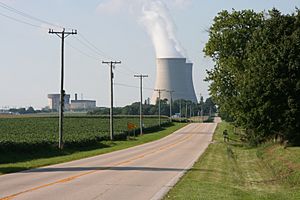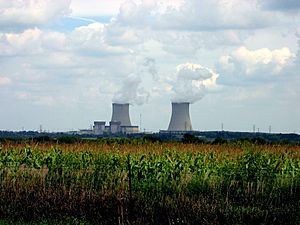Byron Nuclear Generating Station facts for kids
Quick facts for kids Byron Nuclear Generating Station |
|
|---|---|
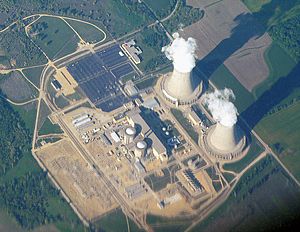
Byron Nuclear Generating Station
|
|
| Country | United States |
| Location | Rockvale Township, Ogle County, near Byron, Illinois |
| Coordinates | 42°4′27″N 89°16′55″W / 42.07417°N 89.28194°W |
| Status | Operational |
| Construction began | April 1, 1975 |
| Commission date | Unit 1: September 16, 1985 Unit 2: August 2, 1987 |
| Construction cost | $4.5 billion (2007 USD) |
| Owner(s) | Exelon |
| Operator(s) | Exelon |
| Website Byron Generating Station |
|
The Byron Nuclear Generating Station is a nuclear power plant located in Ogle County, Illinois. It's about 2 miles (3.2 km) east of the Rock River. This plant uses two special machines called pressurized water reactors. These reactors, named Unit 1 and Unit 2, started making electricity in September 1985 and August 1987. The company Exelon Corporation owns and runs the plant today.
The Byron plant helps power homes and businesses in northern Illinois and the city of Chicago. In 2005, it made enough electricity for about 2 million average American homes. Over 600 people work at the station, mostly from nearby counties. You can easily spot the plant because of its two very tall cooling towers, which are about 495 feet (151 meters) high. There was a time when some people were concerned about tiny amounts of tritium (a radioactive substance) found in the groundwater near the plant. This led to a new law in Illinois. Now, all nuclear plants must report any such findings to the state very quickly.
Contents
History of the Byron Nuclear Plant
Construction of the Byron Nuclear Generating Station began in 1975. It was built on a large area of land, about 1,782 acres (7.2 square kilometers). This site is located southwest of Rockford, Illinois, and south of the city of Byron.
Early Concerns and Approval
Before the plant was finished, some groups were worried about its safety and whether it was truly needed. In 1981, groups like the League of Women Voters filed a lawsuit to try and stop the plant from opening. In 1984, the U.S. Nuclear Regulatory Commission (NRC) at first refused to let the plant operate. This was because of concerns about the quality of work done by some contractors during construction. However, after a careful re-inspection of many parts of the plant, the NRC changed its decision. They gave permission for the plant to start operating in October 1984.
Starting Operations and License Renewal
Byron Unit One received its operating license in February 1985. Unit Two got its license in January 1987. On September 16, 1985, Unit One officially began making electricity. The plant's original licenses were set to expire in 2024 and 2026. However, in 2013, Exelon applied to renew them. In November 2015, the NRC approved the renewal. This means Unit One can now operate until October 2044, and Unit Two until November 2046.
Future of the Plant
In August 2020, Exelon announced plans to close the Byron plant in 2021. This decision was made for economic reasons, even though the plant had licenses to operate for many more years. Exelon is still talking with government leaders to try and find ways to keep the plant open.
How the Plant Works and What It Produces

The Byron plant has two large pressurized water reactors. Each reactor can produce over 1,000 MWe of electricity. Together, the two units can generate 2,347 megawatts (MW) of electricity. In 2009, the plant produced enough power for 2 million average American homes. The two tall cooling towers at Byron stand 495 feet (151 meters) high.
Water Use at Byron

The plant uses water from the Rock River for cooling. This river is about 2 miles (3.2 km) west of the plant. The water used to cool the reactors is then cooled down in the plant's two cooling towers. After cooling, this water is sent back into the Rock River. Other water from the plant's special waste treatment system is checked for any contamination. If it's clean, it's also released back into the river.
Plant Employees and Economic Impact
According to Exelon, about 850 employees and 50 contractors work at the Byron station. Most of these workers live in the nearby Ogle and Winnebago Counties. In 2009, the plant paid over US$31 million in taxes to local communities.
Increasing Power Output
The NRC has approved two upgrades to increase the power output of each reactor since they first started. The first upgrade in 2001 added 175.6 MWt (thermal megawatts) to each reactor. The second upgrade in 2014 added another 58.4 MWt. These upgrades increased the plant's total power capacity.
Groundwater and Environmental Safety
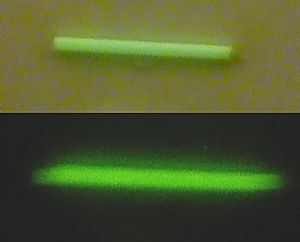
Below the power station, there are two underground water sources called aquifers. These are separated by a layer of rock, so they don't mix.
Tritium Findings and New Laws
In February 2006, Exelon reported finding slightly higher levels of tritium in the groundwater under the plant. Tritium is a very low-level radioactive material. The company stated that these levels were not a risk to public safety. This finding, along with similar situations at other nuclear plants in Illinois, led to new rules. The state of Illinois passed a law requiring nuclear power plants to report any release of radioactive materials into the soil or water within 24 hours. Before this law, companies only had to report such releases to the federal NRC. This new law also requires regular inspections of all Illinois nuclear power plants by state agencies.
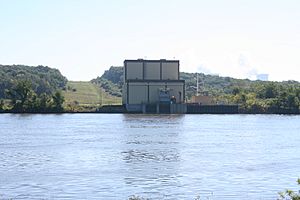
Plant Safety and Inspections
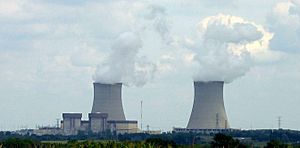
The Nuclear Regulatory Commission (NRC) regularly inspects nuclear power plants like Byron. They use a color-coded system to show how safe a plant is. "Green" means very low risk, which is the best rating. "White," "yellow," and "red" mean increasing levels of risk.
Inspection Results and Incidents
As of 2007, Byron Nuclear Generating Station usually scored "green" in almost all inspection areas. This means it was operating very safely. There have been a few minor incidents over the years. For example, in 2006, a small fire happened in a heater at the plant. It was quickly put out, and the reactors were not affected. In 2012, an electrical problem caused Unit 2 to temporarily shut down. During this event, a very small amount of tritium was released, but the NRC said it was not a threat to the public. After this, Exelon replaced all the insulators in the plant's switchyard to prevent similar issues.
People Living Near the Plant
The Nuclear Regulatory Commission sets up two special zones around nuclear power plants for emergency planning.
- The first zone is about 10 miles (16 km) around the plant. This zone is for concerns about breathing in any airborne radioactive material.
- The second zone is about 50 miles (80 km) around the plant. This zone is for concerns about eating food or drinking liquids that might be contaminated.
In 2010, about 25,679 people lived within 10 miles of the Byron plant. About 1,273,771 people lived within 50 miles. The city of Rockford is about 17 miles (27 km) away.
Security Measures
Security at the Byron plant is very important. After the events of September 11, 2001, the United States Coast Guard created a special "security zone" around the plant. This was part of a larger effort to make nuclear facilities in the U.S. safer. Today, the plant's owner, Exelon, handles security directly with its own employees.
Earthquake Risk
The NRC studies the risk of earthquakes that could cause damage to nuclear reactors. Their estimate for the Byron plant is very low. They calculated that the risk of an earthquake strong enough to cause serious damage to the reactor at Byron is about 1 chance in 172,414 each year.
See also
 In Spanish: Central nuclear de Byron para niños
In Spanish: Central nuclear de Byron para niños


